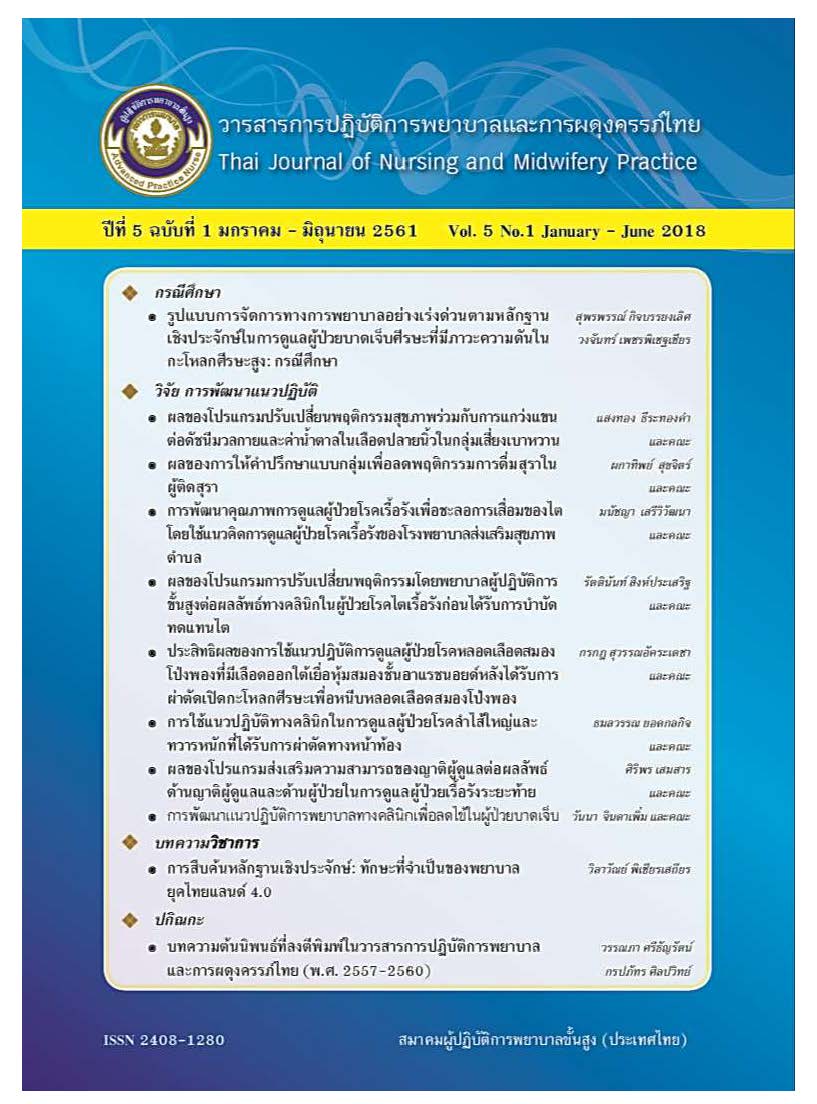Evidence-based Fast Track Nursing Management in Care of Patients with Traumatic Brain Injury Having Increased Intracranial Pressure: A Case Study
Main Article Content
Abstract
Patients with traumatic brain injury require prompt and standardized critical care management from healthcare providers. This should begin at time of injury until definitive care is executed in order to prevent increased intracranial pressure and secondary brain injury. This paper aims to present the case study demonstrating the implementation of nursing fast track management in patients with traumatic brain injury having increased intracranial pressure, from the pre-hospital care to in-hospital care. It was revealed that the important nursing fast track at the scene and at a community hospital was provided following the Advanced Trauma Life Support (ATLS) principles until the patient's vital signs were stable, and then neurological signs were monitored continuously. Moreover, care provided at a tertiary hospital should be definitive, starting from an emergency department to an in-patient unit. There should be a multidisciplinary care team composing of neuro-surgeon, personnel from operating room, x-rays department, pathological department and nurses of in-patient unit who use valid and updated evidence for the best patient outcomes.
Downloads
Article Details
References
2. Taylor CA. Traumatic brain injury–related emergency department visits, hospitalizations, and deaths—United States, 2007 and 2013. MMWR Surveill Summ 2017; 66.
3. Health Data Center [Internet]. 2018 [cited 2018 Jan 5]. Available from: https://hdcservice.moph.go.th/hdc/reports/report.php?source=formated/death298.php&cat_id=491672679818600345dc1833920051b2&id=b4ea22252bb533f3f9225dfcab83d43a.
4. Prapan S, Rattanalert S. Management of increase intracranial pressure in severe head injury patient. Neurological Surgery 2011; 2: 36-47.
5. Sadoughi A, Rybinnik I, Cohen R. Measurement and management of increased intracranial pressure. Crit Care Med 2013; 6, (Suppl 1: M4): 56-65.
6. Treggiari MM, Schutz N, Yanez ND, Romand JA. Role of intracranial pressure values and patterns in predicting outcome in traumatic brain injury: A systematic review. Neurocrit Care 2007;1;6(2): 104-12.
7. Puanpathom N. Traumatic brain injury. Songkhla: Lim Brader; 1996.
8. Haddad SH, Arabi YM. Critical care management of severe traumatic brain injury in adults. Scand J Trauma Resusc Emerg Med 2012; Dec;20(1): 12.
9. Punjaisri S, Puanpathom N, Werasarn K. Clinical practice guidelines for traumatic brain injury. Bangkok: Tana Press; 2013.
10. Chou R, Totten AM, Pappas M, Carney N, Dandy S, Grusing S, Fu R, Wasson N, Newgard C. Glasgow coma scale for field triage of trauma: A systematic review. AHRQ 2017; 16:1-12.
11. McBryde FD, Malpas SC, Paton JF. Intracranial mechanisms for preserving brain blood flow in health and disease. Acta Physiol 2017; Jan 1;219(1): 274-87.
12. Becker DP, Miller JD, Ward JD, Greenberg RP, Young HF, Sakalas R. The outcome from severe head injury with early diagnosis and intensive management. J Neurosurg 1977; Oct;47(4): 491-502.
13. Ponglaohapun U, Wongwatunyu S, Khuwatsamrit K. Nursing activities and factors related to increased intracranial pressure in head injured patients. Rama Nurs J 2009; 15:221-232.
14. Thongchai C. Best practice: Evidence based practice information sheets for health professionals tracheal suctioning of adults with an artificial airway. The Joanna Briggs Institute 2000; 4: 1-6.
15. Carney N, Totten AM, O'reilly C, Ullman JS, Hawryluk GW, Bell MJ, Bratton SL, Chesnut R, Harris OA, Kissoon N, Rubiano AM. Guidelines for the management of severe traumatic brain injury. Neurosurgery 2017; Jan 1;80(1): 6-15.
16. Donabedian A. The quality of care: how can it be assessed? Archives of pathology & laboratory medicine. 1997 Nov 1;121(11):1145.
17. Jennett B, Bond M. Assessment of outcome after severe brain damage: A practical scale. Lancet 1975; Mar 1;305(7905): 480-4.


